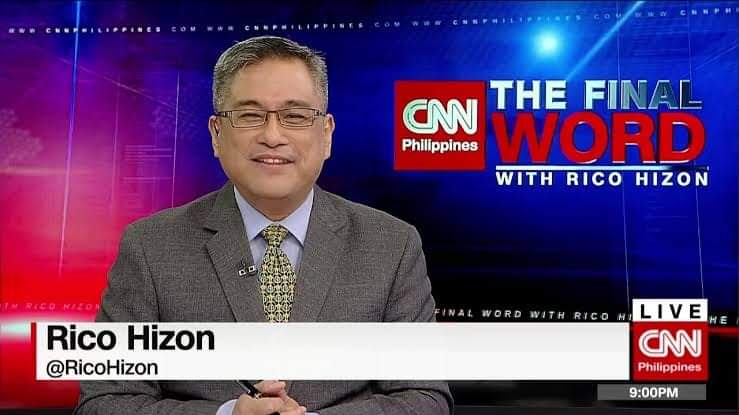Plantacion de Sikwate was featured at the AGRICULTURE segment of MANILA BULLETIN. Thank you Ms. Jazzine for the write-up.
Category: TRI-Media
Chris Fadriga guests on CNN PHILIPPINES
CNN PHILIPPINES RICO HIZON on the The Final Word. June 3, 2022
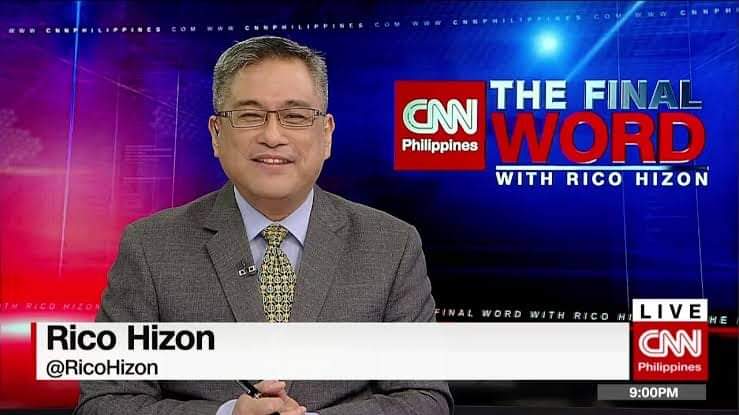
Segment: Pinoy Pride << click to watch
Friends of Plantacion de Sikwate: Everyday Goodwill Television
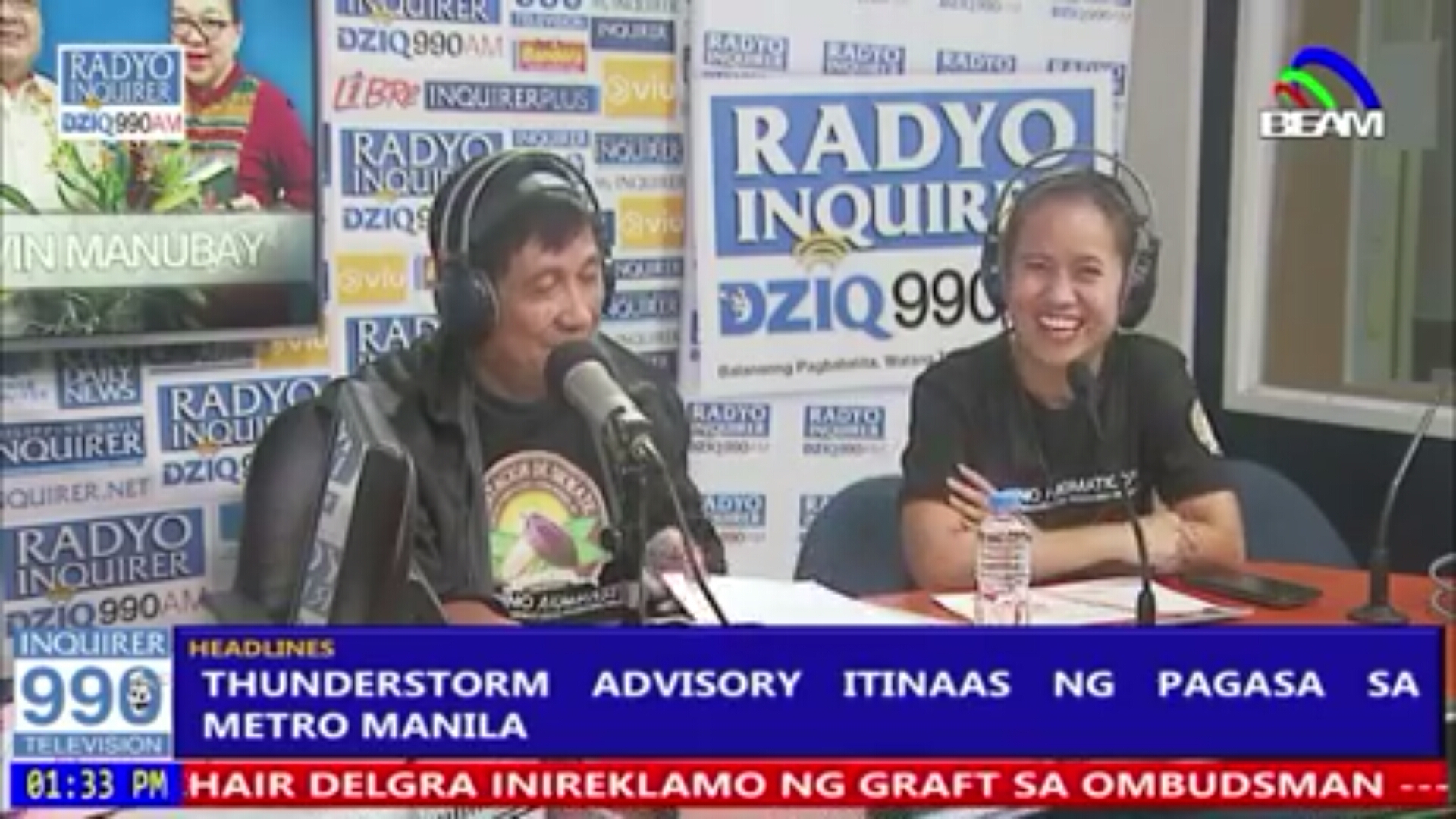 Today we had an opportunity to guest in Everyday Goodwill Television of Radyo Inquirer 990AM.
Today we had an opportunity to guest in Everyday Goodwill Television of Radyo Inquirer 990AM.
We were last invited on November 21, 2017 and our guesting this afternoon was to give them an update on where we have progressed as an association
excerpts from the show:
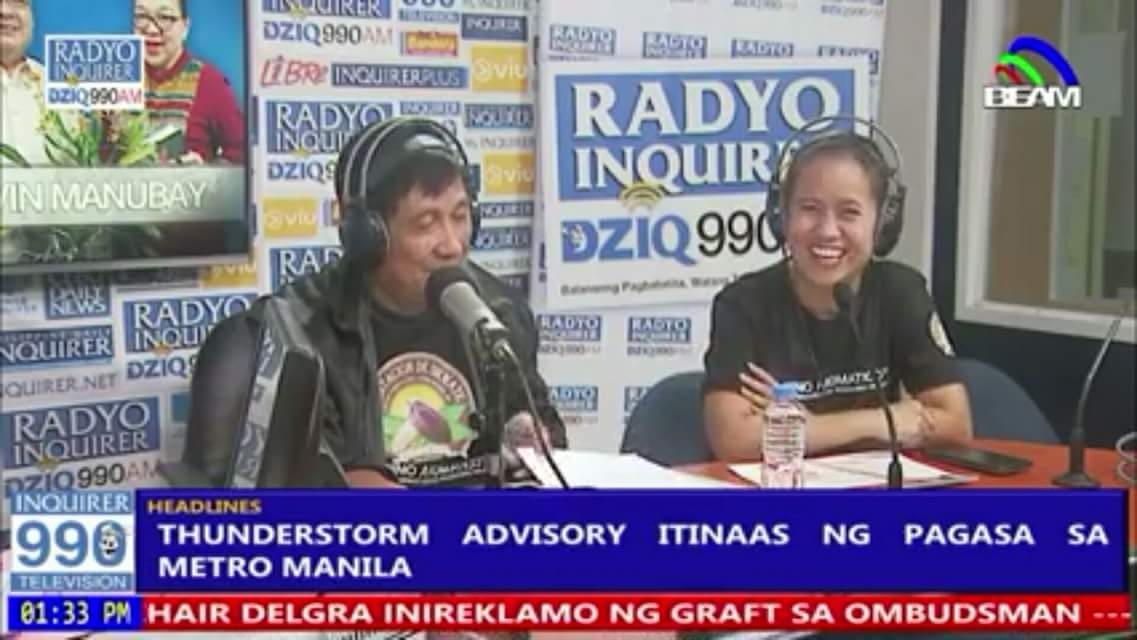
Maraming salamat sa pag imbita muli sa amin. Isa po itong magandang pagkakataon para sa mga magsasaka ng cacao. ~ Romela Beltran-Fabula

We average 1-2 visitors a month from foreign investors or chocolatiers. Ayon sa kanila, ang Heirloom Cacao natin ay hinahatulad sa Lamborghini or sa Ferrari. – Mel Santos
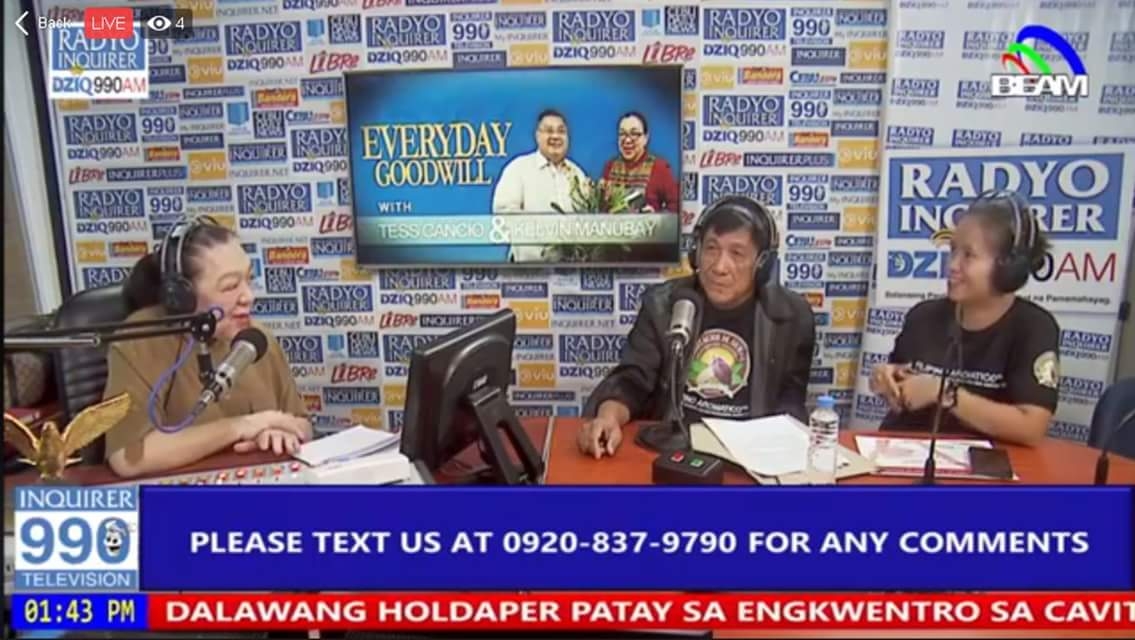
Isang bumisita din sa amin ay taga Sweden. Ma’am Angela and Tibor Vargas. Pumunta sila sa Camalig. They wanted to connect directly sa ating farmer. That way, si farmer, mabigyan natin ng premium price dun sa harvest nila . Yun naman ang pinaga goal natin. Ang mabigyan si farmer ng magandang income si farmer through Heirloom cacao. Yun po ang isang magandang ginagawa ng PDS para walang trader pa. – Romela Beltran-Fabula
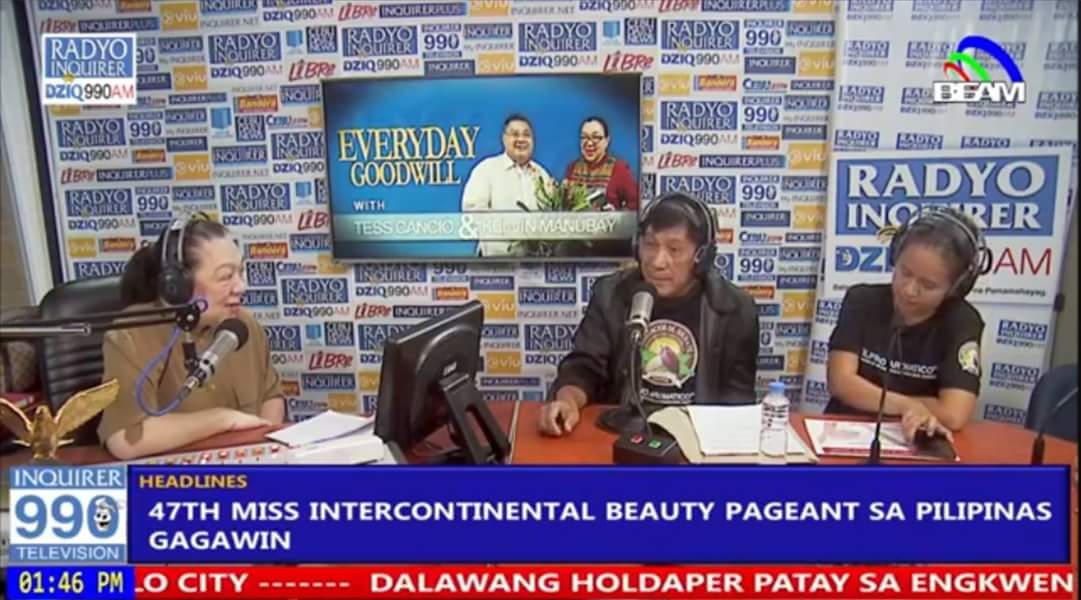
Tamang fermentation and drying technology niya . na naituro ni Steven DeVries ng America, isa sa mga founders ng Heirloom Cacao Foundation. Ang naituro niya ay ang ginagamit naming ngayon sa protocols natin. – Mel Santos
Token of Appreciation
As a Token of Appreciation for acknowledging and supporting the efforts of Plantacion de Sikwate Cacao Producers Association, Inc.
on our propagation of the PHILIPPINE HEIRLOOM CACAO –
remnants from the Manila-Acapulco Galleon Trade in the 1700s, we gave Tess Cancio the FRIENDS OF PLANTACION DE SIKWATE.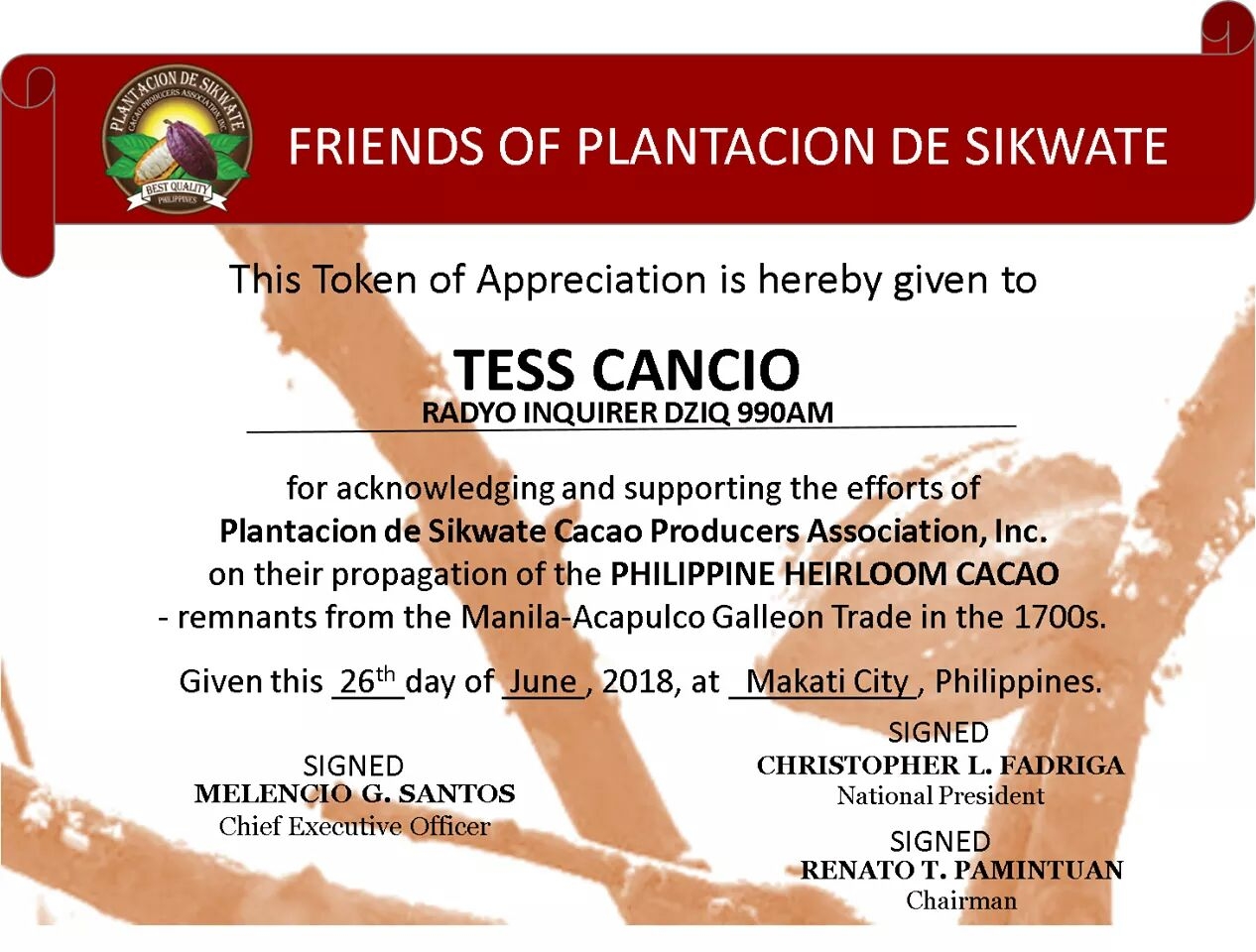
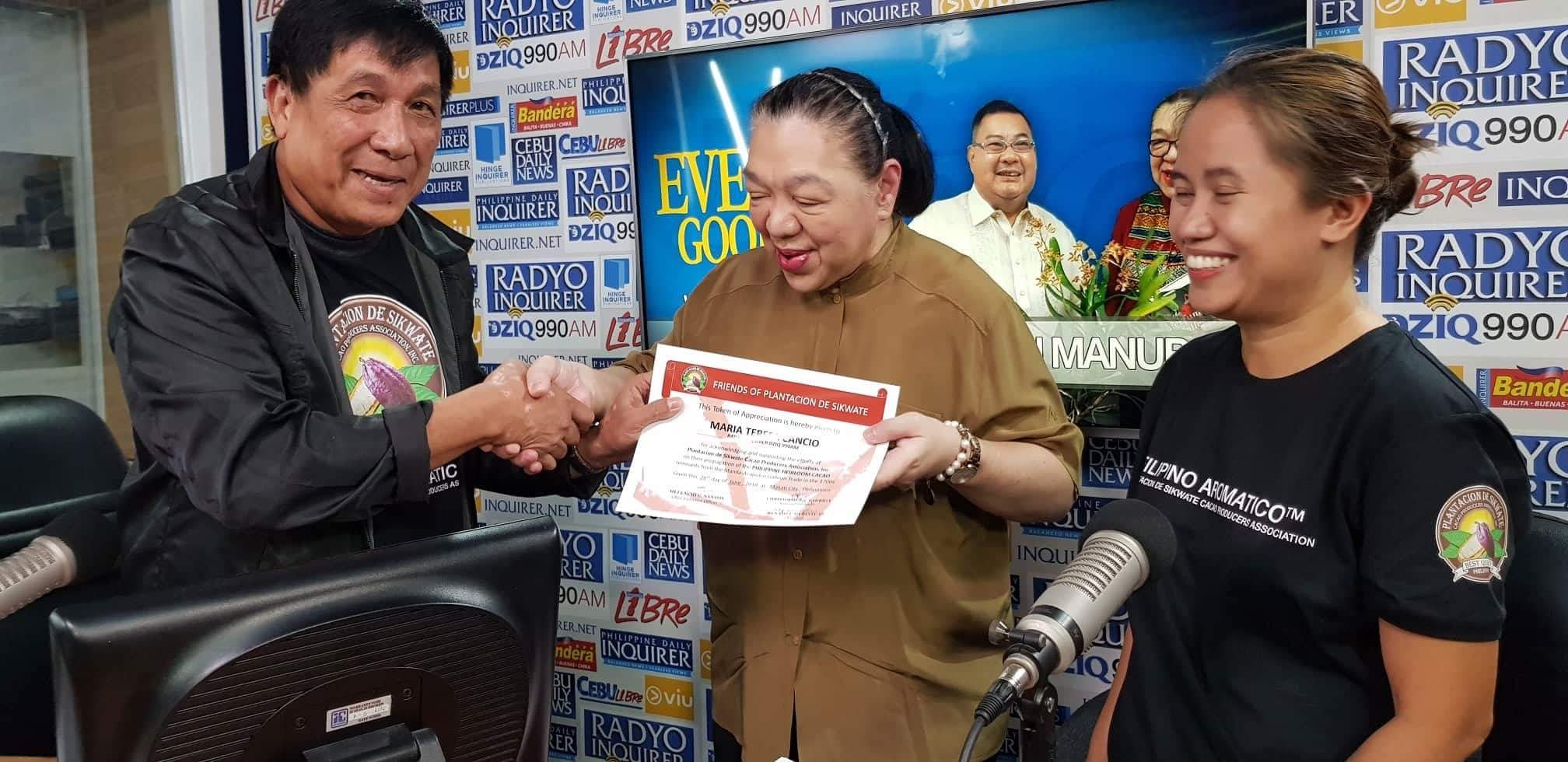
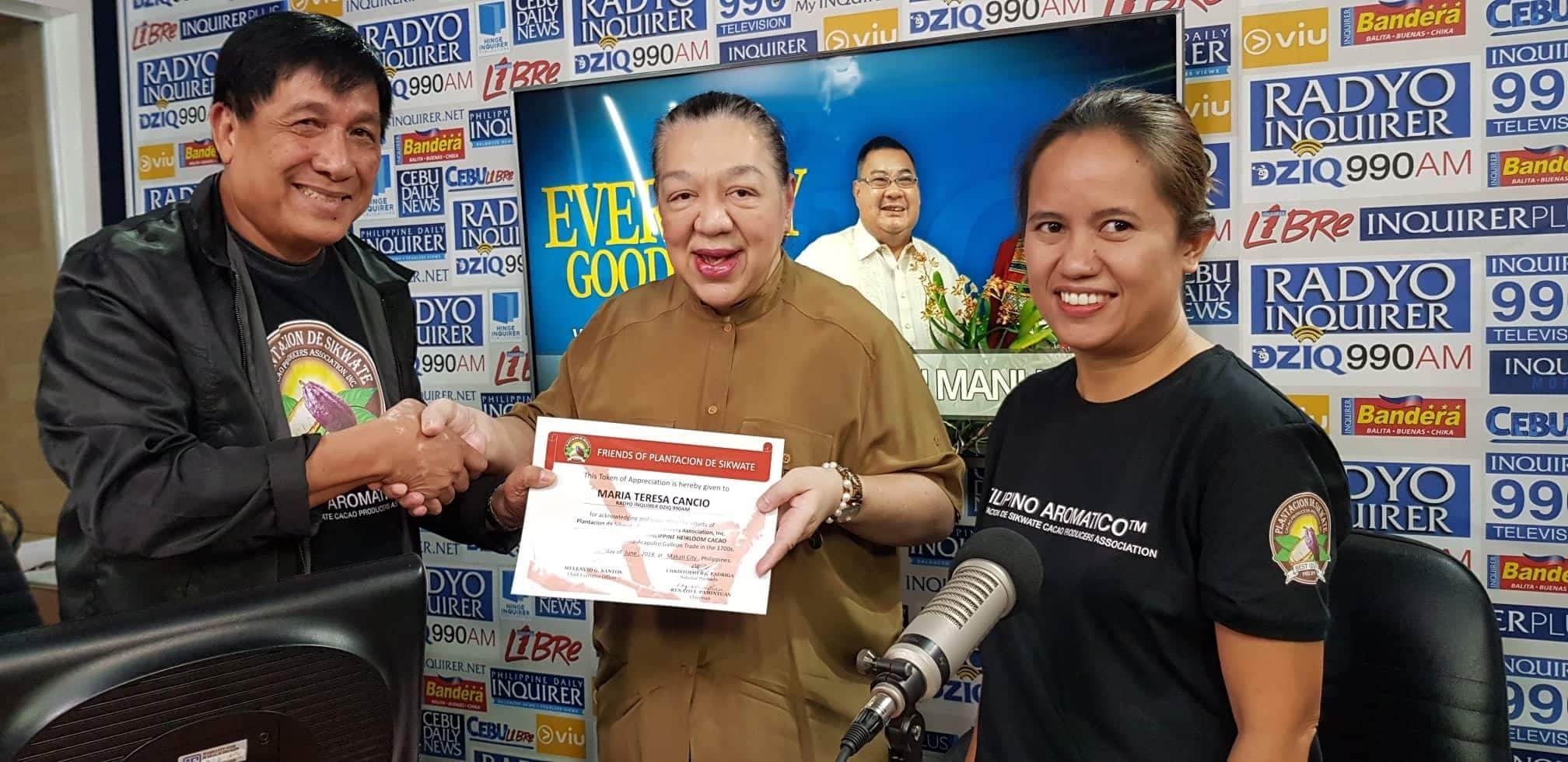
Watch the show here
CACAO & Everyday Goodwill
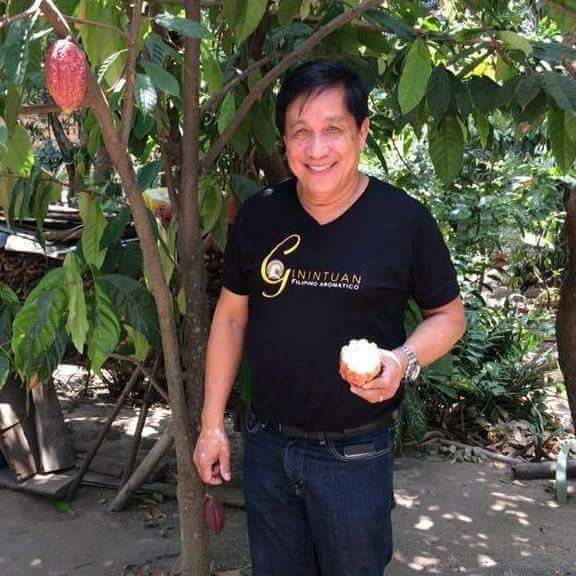 All it takes is a determined and passionate farmer to grow and propagate a rare variety of cacao called the Criollo. So-called critics may disagree but look behind me. That is our contribution to the Cacao industry; our very own GININTUAN.
All it takes is a determined and passionate farmer to grow and propagate a rare variety of cacao called the Criollo. So-called critics may disagree but look behind me. That is our contribution to the Cacao industry; our very own GININTUAN. 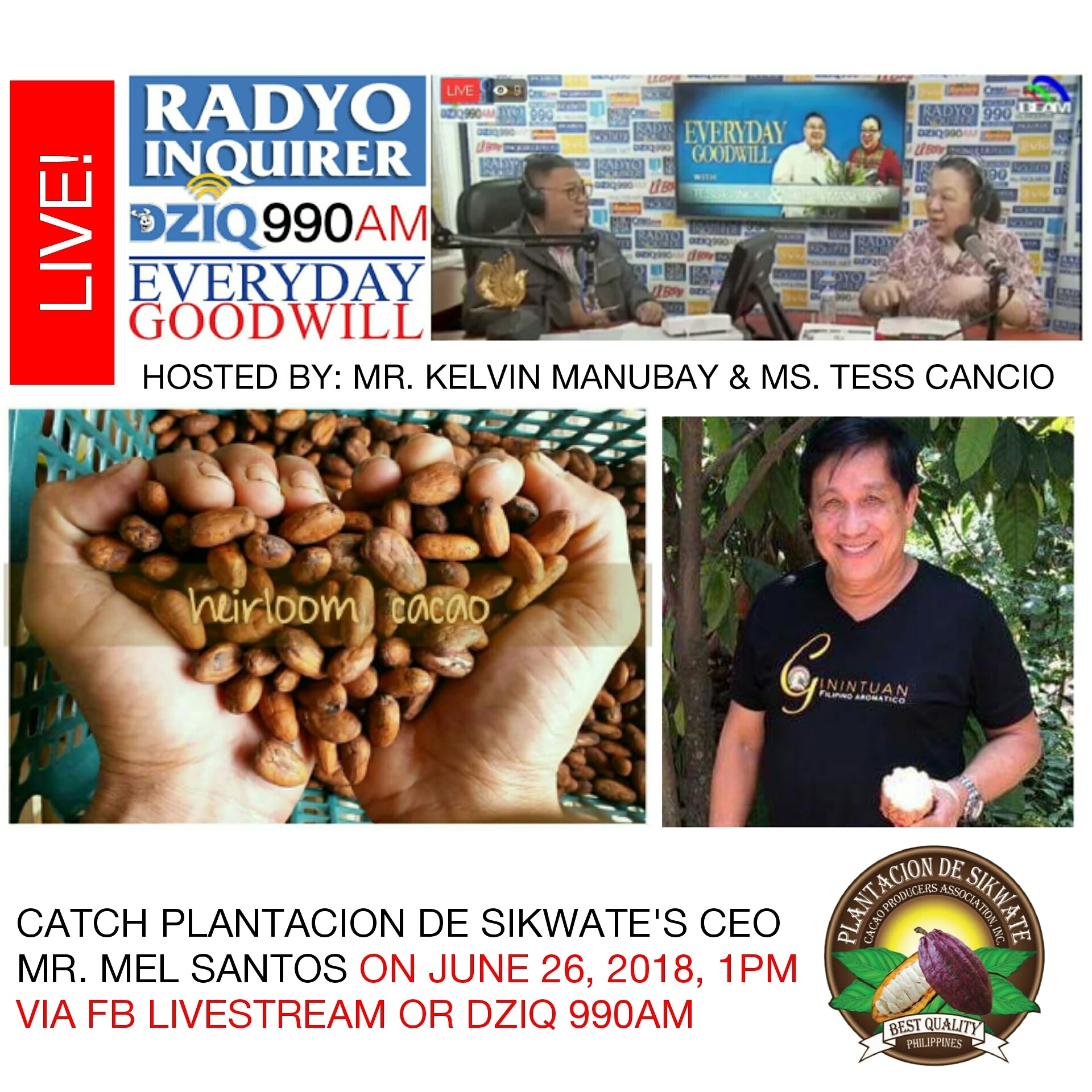 Come and join me on June 26, 2018, 1PM at INQUIRER’s Everyday Goodwill live at DZIQ 990AM or via their FB livestream.
Come and join me on June 26, 2018, 1PM at INQUIRER’s Everyday Goodwill live at DZIQ 990AM or via their FB livestream.
– Mel Santos, PDS Chief Executive Officer
Everyday Goodwill Radio Program at Inquirer 990FM
Here is Everyday Goodwill Radio Program at Inquirer 990FM. For your easier viewing.
Our PDS Chief Executive Officer Mr. Mel Santos talked about the Filipino Aromatico as well as how Cacao Planting is an Integrated Farming endeavor for all farmers in the Philippines.
Everyday Goodwill Radio Program at Inquirer 990FM
Here is Everyday Goodwill Radio Program at Inquirer 990FM. For your easier viewing at FB. Our PDS Chief Executive Officer Mr. Mel Santos talked about the Filipino Aromatico as well as how Cacao Planting is an Integrated Farming endeavor for all farmers in the Philippines.
Gepostet von Plantacion de Sikwate Cacao Producers Association, Inc. am Samstag, 25. November 2017
PLANTACION DE SIKWATE – DZMM TeleRadyo 630 LIVE Interview
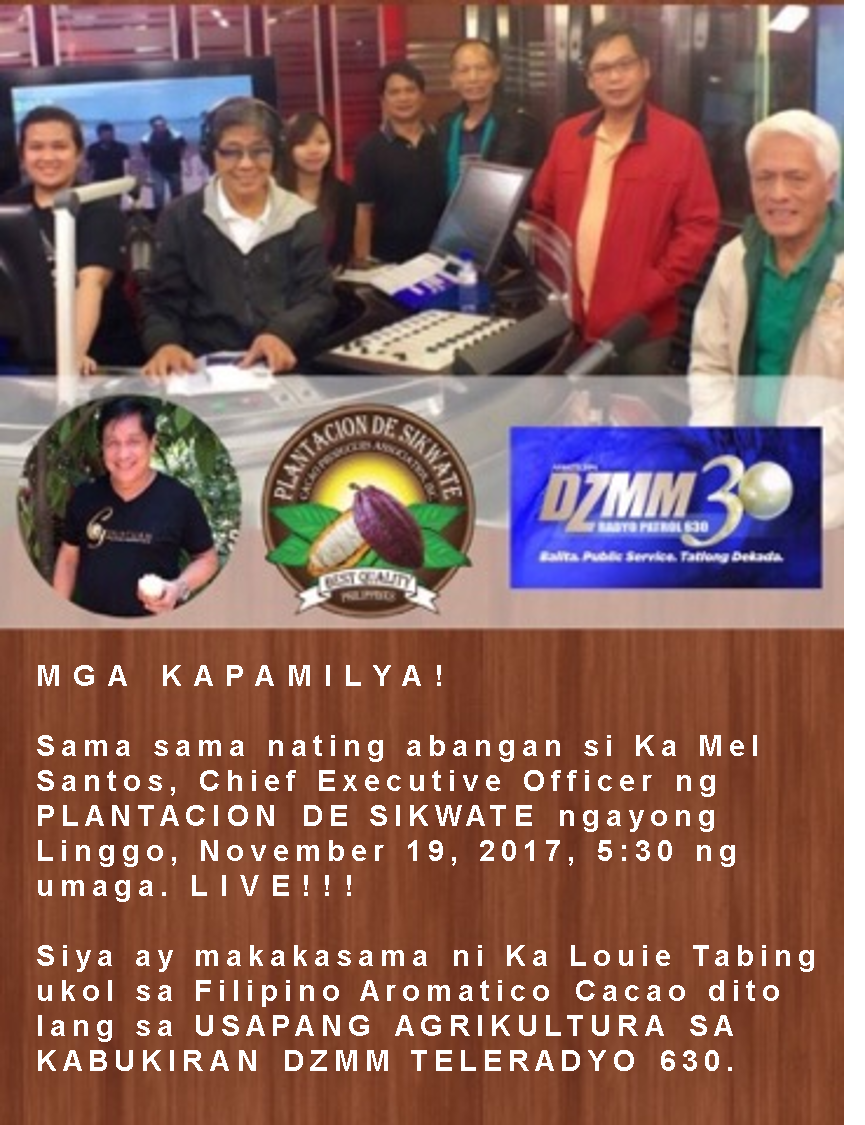
MGA KAPAMILYA!
Sama sama nating abangan si Ka Mel Santos, Chief Executive Officer ng PLANTACION DE SIKWATE ngayong Linggo, November 19, 2017, 5:30 ng umaga. LIVE!!!
Siya ay makakasama ni Ka Louie Tabing ukol sa Filipino Aromatico Cacao dito lang sa USAPANG AGRIKULTURA SA KABUKIRAN DZMM TELERADYO 630.
PDS LIVE interview at RPN 9 Channel 44 Cebu (Video)
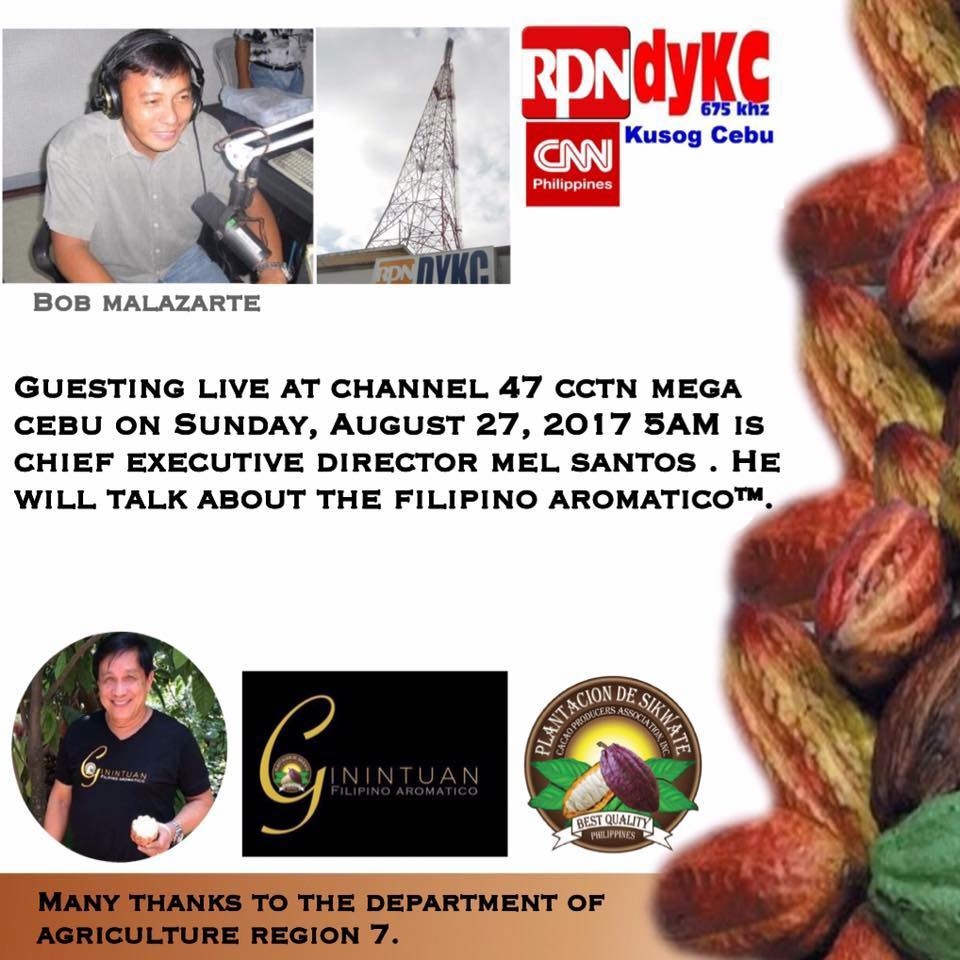
[embedyt] http://www.youtube.com/watch?v=4l3CokeYPNM[/embedyt]
PDS Seminar Invitation at DA-ATI, Q.C.

Dear Cacao Friends of PDS, I have finally met the host Mr. Louie Tabing of Let’s Talk Agriculture (a radio segment at DZMM 630, powered by one of leading TV networks in the country, ABS-CBN) when we were invited to their seminar at the DA-ATI BUILDING in Quezon City.
I felt so happy to have been given the chance to present the PDS Way of Cacao Farming infront of close to a hundred participants this morning.
The crowd was so overwhelming! I felt like a Hollywood Superstar lol! My name cards were requested to have me sign an autograph on it. (wish I brought more though) 🙂
In behalf of Team PDS of Luzon Manny Carpio, Oji Reyes, Basil Bolinao, Zaldi and I, thank you so much for the warm welcome!
It was raining but it did not hamper the participants to attentively listen to our presentation. They learned the Search for Criollo, how to plant cacao, how much it will yield and who are the buyers of their harvested cacao.
I could talk for hours but it still went on overtime even after close to 2 hours of Q&As!
I am happy to have ignited the interest of our farmers who participated in the seminar.
Thank God we were invited for another guesting to the next seminar they will be hosting soon.
Kudos to our Technical Support Team, my fellow Members of the Board and to you dear cacao friend that inspite the stormy weather, your sunshine helped us share the PDS “Teach, Educate, and Learn” mantra on Cacao Farming.
Do follow us here and at our Facebook page for the date and place of the next seminar. Thank you everyone and happy planting!
MEL SANTOS, Chief Executive Director, PDS





















DZMM 630 Usapang Agrikultura sa Kabukiran Radio Guesting

Catch PDS Chief Executive Director Mel Santos on Sunday, July 23, 2017 LIVE! at DZMM 630.
Once a dreamer of vast lands populated by different Cacao varieties planted by Filipinos who share the similar dream. Now his dream unfolds to find that one variety that has a historical affinity to the country.
He is one of the founders of Plantacion de Sikwate Cacao Producers Association, Inc. and Vice Chairman of the sub-committee of the Philippine Council for Agriculture and Fisheries (PCAF) for Cacao.
He will be interviewed live via phone patch by Mr. Louie Tabing on how are the ways to plant cacao.
Usapang Agrikultura sa Kabukiran is a Radio Show powered by one the leading networks in the country, ABS-CBN.
<Here is the English version of the interview.>
“Let’s talk Agriculture at the Farm”
<Usapang Agrikultura sa Kabukiran DZMM 630 >
13-minute live interview via phone patch by radio station segment host Mr. Louie Tabing
—————-
Mr. Louie Tabing (LT): We have here on the show, via phone patch is Mr. Mel Santos from Cebu; Good morning to you, Mr. Santos.
Mr. Mel Santos (MS): The morning is good Sir Louie, to the group behind the show and to those who are listening right now.
LT: Planting Cacao – the one we make into chocolates. I would like to know, how vast is your plantation (in terms of hectares)?
MS: It is not that vast, if you ask me, but we have already planted 3,300 trees.
LT: Huh! Really, you have about 3,300 trees? How large would that be in terms of hectares?
MS: That is 3 hectares, Sir Louie.
LT: So that would be about 1,000 trees that can grow in 1 hectare (of land). I would like to ask what is the normal (average) distance when you plant the trees?
MS: The normal (average) is 3 x 3 or 3 meters x 3 meters. However, if your land is on a slope or hilly area, you may plant by 2.5 meters by 3 meters.
LT: Alright so you can plant more of trees in one hectare (if it’s on a slope or hill).
MS: Yes.
LT: Actually, if it is on a 3 x 3 distance (from one tree to another) you can plant around 900 plants in a hectare.
MS: To be exact, that would be 1,111 but we recommend planting 1,000 trees to give a provision for walking space.
LT: Oh I see. What is your expected yield in terms of harvested cacao pods? Since as an entrepreneur, the first thing I would be asking is how much will I be earning in this investment.
MS: Yes. When you venture into cacao planting, you first need to ask yourself if you love and respect planting crops. (Mother Nature) when we come to terms with that love for Nature and have followed all the right things to plant cacao, you can harvest 3,000KG cacao pods.
LT: How much would 3,000KG yield in terms of money? Let’s bring it smaller. For 1KG of harvested pods, how much can I sell it? But wait, we are talking about beans, right or the pods?
MS: These are the beans. Or what we call Fermented Dried Cacao Beans (FDCB).
LT: Oh ok, how much would 1KG cost?
MS: Currently, the FDCBs cost P100 per KG in the market. However, we are promoting a cacao variety that grows faster and has big beans in terms of size. We are mixing two cacao varieties having the more important one called Criollo or Native cacao. So if you get to plant these, you are going to yield 3 – 4 KG per tree in a year.
LT: If I am not mistaken, that would roughly cost around P300,000 in one hectare?
MS: Not just that. The gross amount would still have to be multiplied to a thousand trees. That would yield 3,000KG. What we are planting right now is called the Filipino Aromatico.
LT: Hold on. 3,000KG multiplied by P100 leads you to P300,000.
MS: Yes but if you plant the Filipino Aromatico or Fine Aromatic, a combination of two cacao varieties you can sell it up to as much as P300 per 1KG.
LT: P300 per 1KG?
MS: Yes sir.
LT: That would be multiplied by 3, you will get P900,000.
MS: Yes. Those cacao beans are for the Niche market. <The artisan chocolate makers would be the buyers.>
LT: Earlier, you mentioned that these cacao beans are fermented. Please explain to us how fermentation of these cacao beans goes about.
MS: Alright. Our ancestors followed the traditional way of “fermenting” cacao. They allow the beans to be sucked before letting them dry under the sun.
LT: Hold on. What or who sucks the beans?
MS: Little children.
LT: <laughs> Oh yes! I remember that. When I was younger, our grandparents asked us to eat the white covering of the cacao beans. They also warned us not to throw the beans away after eating them.
MS: Yes. But the modern way that we are following does not require little kids to eat the white pulp. That sweet skin actually allows the cacao beans to undergo a better process of fermentation. For the people who understand the “bean to bar” process, the white bean cover is important. Without that skin, the chocolate end product would not taste good.
LT: This means that after opening the cacao pod, you extract the beans then suck the white pulp?
MS: No more. You open the pod, take the beans out, ferment it straight for 5 days then let it sun dry for another 5 days.
LT: The process then would enable you to achieve the sour taste of the beans. Listeners, you need to remember that you do not have to eat the white pulp before fermenting it. But do you need to clean the beans? Do you need to wash it under tap water?
MS: No need.
LT: Isn’t it that the process of fermenting these cacao beans would require you to store them in containers and keep them away from sunlight?
MS: No. The modern way in fermenting cacao beans is by placing them in wooden crates or boxes. We store them there and every 24 hours we need to mix the beans with our hands. This will create an evenly fermented batch of beans.
LT: Alright, so you need to mix the beans every 24 hours without having to add anything else? Like water?
MS: No need to add water. Just let them be sun-dried after 5 days of fermenting the beans. However, keep in mind that these beans are not to be dried directly under the sun. You need to cover the wooden crate with UV plastic on top.
LT: That is so tedious! Can’t you use a mechanical dryer?
MS: Yes you may. There are other people who use that kind.
LT: That, our avid listeners, is the process of fermenting cacao beans before you go through the process of roasting and grinding them.
MS: That is the process on how to produce the best-tasting chocolates! Sir Louie, I would just like to reiterate the importance of the Filipino Aromatico. Now after our farmers plant the trees and then harvest the pods, they get in touch with buyers or traders who will buy their beans in volumes. Our association aims for is farmers to not be short changed with the fruits they harvest. We would like them to know the way to create their own chocolate bars without exporting the raw products. That way, our farmers will not have to get paid lower prices since they sell it in bulk. To help cacao farmers further, our association launched the Search for the Heirloom Cacao or Criollo.
LT: What color is that? Isn’t it that they come in different shades like red, green and yellow?
MS: Oh those are the exterior hull of the cacao. After opening the fruit, you take the beans out and do a cut-test. You either bite it in half or use a shear to open it. Inside the color will vary. Some beans are color purple, dark purple, light pink or lilac. The hybrids are color violet or purple. The heirloom cacao is color white.
Believe it or not, did you know that these white beans can be located here in the Philippines? The beans originated from Mexico and they were brought to our country through the Manila-Acapulco Galleon Trade in the 1700s. Our ancestors have planted them here in the country. We have successfully grafted these heirloom cacaos. The big bulk can be found in a cacao nursery in San Guillermo in Lipa, Batangas.
LT: Amazing! Mel, apologies for cutting this interview short since we are running out of time. But there are more things to learn about Cacao Planting! We will invite you once again for another chance to discuss more on Cacao Planting. We will also see you next week in our Agri seminar, yes? Before we end this interview, aside from Batangas, where are the other farms located at?
MS: Our association has grafted seedling farms or cacao plantations all over the country. Like Bicol, Batangas, Bohol, Cebu, and Mindanao to name a few.
LT: That is great! For more time to talk about the ways to plant these cacao seedlings, then how to care for the trees, we will reconvene on Sunday. See you then, Mel! Ladies and Gentlemen, that was Mr. Mel Santos from Cebu.

